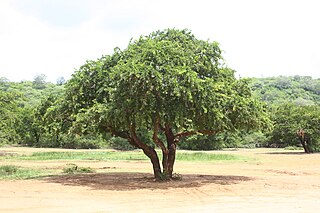
Schinus is a genus of flowering trees and tall shrubs in the sumac family, Anacardiaceae. Members of the genus are commonly known as pepper trees. The Peruvian pepper tree is the source of the spice known as pink peppercorns. They can become an invasive species outside their natural habitats. Schinus polygama, although less well known, is also potentially weedy in mesic areas.

The Limoniinae are a paraphyletic assemblage of genera within the crane flies, Tipulidae, although they can usually be distinguished by the way the wings are held at rest. Limoniines usually hold/fold the wings along the back of the body, whereas other tipulids usually hold them out at right angles. Snow flies such as Chionea scita have no wings at all. Limoniines are also usually smaller than other tipulids, with some exceptions. Limoniinae are a very large assemblage with nearly 10500 described species in 133 genera, and were historically treated as a subfamily, but their classification is in flux; numerous authors recently treated the group at the rank of family, but subsequent phylogenetic analyses revealed that the remaining groups of tipulids render the group paraphyletic. These flies are found in damp places throughout the world, and many species form dense swarms in suitable habitats.

Limonia acidissima is the only species within the monotypic genus Limonia. Common names for the species in English include wood-apple and elephant-apple.

Limonia is a genus of crane flies in the family Limoniidae. There are at least 430 described species in Limonia. It is somewhat of a 'catch-all' genus, where some members should rightly be placed elsewhere.
Limonia novaeangliae is a species of limoniid crane fly in the family Limoniidae.

Limoniini is a tribe of limoniid crane flies in the family Limoniidae. There are about 7 genera and more than 1,400 described species in Limoniini.
Limonia immatura is a species of limoniid crane fly in the family Limoniidae.
Psychomastax deserticola, the desert monkey grasshopper, is a species of monkey grasshopper in the family Eumastacidae. It is found in North America.
Limonia cinctipes is a species of limoniid crane fly in the family Limoniidae.
Limonia liberta is a species of limoniid crane fly in the family Limoniidae.

Limonia annulata is a species of limoniid crane fly in the family Limoniidae.

Chymomyza amoena is a species of fruit fly in the family Drosophilidae. It is found in Europe.
Limonia marmorata is a species of limoniid crane fly in the family Limoniidae.

Limonia communis is a species of limoniid crane fly in the family Limoniidae.
Limonia parietina is a species of limoniid crane fly in the family Limoniidae.
Limonia hudsonica is a species of limoniid crane fly in the family Limoniidae.
Limonia humidicola is a species of limoniid crane fly in the family Limoniidae. It can be found in Southern Canada, across the United States, and into Central America, commonly in shady, wet areas along streams.
Limonia shannoni is a species of limoniid crane fly in the family Limoniidae.
Limonia rostrata is a species of limoniid crane fly in the family Limoniidae.






